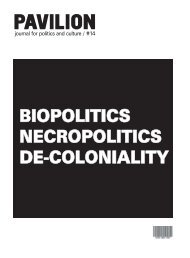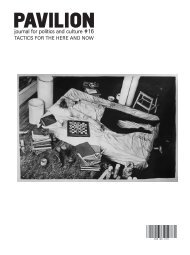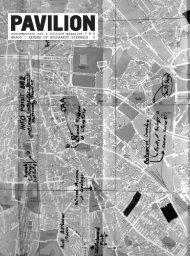PAVILION
PAVILION
PAVILION
- No tags were found...
You also want an ePaper? Increase the reach of your titles
YUMPU automatically turns print PDFs into web optimized ePapers that Google loves.
Bucharest and its Utopia<br />
I feel it's imperative that Bucharest should be<br />
reconstructed; I have tried to sketch a new<br />
urban orientation that can be perceived as<br />
utopian.<br />
In fact, urbanism is an art that should scrutinize<br />
into the future. The city builders lacking foresight<br />
will be always left behind real life. Until<br />
they spot an urgent need coming up, hundreds<br />
of them are hovering and this sort of laggard<br />
race in the cavalcade of time is somehow ridiculous.<br />
Urbanism demands drastic, daring solutions<br />
able to anticipate future needs. Its material<br />
is huge, its means are revolutionary, while its<br />
plan needs be utopian.<br />
If our liberal age imperatively demands a policy<br />
to reorganize the social, economic life, architecture<br />
is just beginning to think about it; urbanism<br />
can be defined as directed architecture.<br />
Although it wasn't known as a science, urbanism<br />
was tightly connected with the art of building<br />
in all cultures, for all peoples. Starting with<br />
the Egyptians, the Chinese, the Romans,<br />
through the Middle Ages, the Renaissance, until<br />
the last century, the art of tailoring Cities was a<br />
geometrical application on the ground.<br />
You will find the rules of geometry wherever<br />
man's mind invented things and its hands chiseled<br />
them, that is, the straight line, pure surface,<br />
and simple volume. This is why Khorsabad,<br />
Peking, as well as the Renaissance towns and<br />
those of Louis xIV created order by means of<br />
geometry.<br />
Only the barbaric ages - the dark Middle Ages<br />
and the unhappy 19th c. architecture - avoided<br />
geometry. Such cities that sprawled at random<br />
represent a regression of human conscience<br />
and art. Being a compelling factor, geometric<br />
order checks the individual freedom and favours<br />
the community interest, its free development.<br />
The late 19th century liberal democracy wasn't<br />
[362]<br />
Marcel Iancu<br />
propitious at all for urban development. Most of<br />
the Western cities, created in the Middle Ages,<br />
throve at on amazing speed during the lost century,<br />
a thoroughly disoriented time in matters of<br />
architecture and urbanism. The traffic problem<br />
was added up to that of city extension.<br />
In Paris, for instance, there was on annual average<br />
growth rate of 6,000 vehicles between 1890<br />
and 1910, and since 1919 the annual rate<br />
amounted 80- 100,000. Between 1800 and<br />
1900 its population grew up with 1,500,000<br />
inhabitants, while in the following 30 years it<br />
added almost one million souls. This is true for<br />
all the European capitals, not only for Paris;<br />
they all showed this spectacular growth. Why?<br />
The machine made human production grew ten<br />
times more; the factories attracted the proletariat,<br />
the cities intensified their race for new outlets,<br />
while traders sought for markets; due to the<br />
machine, man increased his time off ten times<br />
by creating speed and means of transport that<br />
shrank space.<br />
This speedy development found a decadent,<br />
unprepared architecture and a greenish urbanism.<br />
The problem of city development was made difficult<br />
by the traffic problem; in New York, when<br />
the skyscrapers pour out thousands and thousands<br />
of people into the black and narrow<br />
streets, the traffic is jammed. Then what's the<br />
use of one-way and cross-road traffic signs,<br />
once you have to stop every 150 steps. It is a<br />
well-known joke about the American who is said<br />
to walk on top of stuck cars, where ladies have<br />
enough time to knit a pair of socks at every<br />
street corner.<br />
There is no measure taken against the increasing<br />
traffic flow, no regulations to forbid higher<br />
buildings in the town centre, no land expropriation<br />
to widen the streets, there is nothing at all<br />
to show the extent of the modern city tumultuous<br />
life indeed.<br />
In the very moment of the deepest anxiety,<br />
when apparently there was no way out, when<br />
the city noise became unbearable, when a comfortable<br />
and hygienic living seemed impossible<br />
to reach, when the aesthetics was compromised<br />
and urbanism made prisoner, then the<br />
modern thinkers highlighted some unexpected<br />
and wonderful prospects for the cities of the<br />
future.<br />
Everything that has already been experienced<br />
by the Western big cities, has happened to a<br />
certain extent in our own country, and if not, it<br />
will occur very soon on a large scale.<br />
Almost against its own will-and less due to its<br />
awkwardness - Bucharest has changed its spirit;<br />
whoever happens to visit it after twenty years<br />
can hardly recognize it. Obviously, our city<br />
favoured a new life form and overlooked those<br />
old art vestiges like the Old Saint George<br />
Church and Colțea Tower that could have<br />
embellished it.<br />
We undergo a stage of full recovery. The buildings<br />
in the commercial centre grow higher and<br />
higher; the old and uncomfortable houses make<br />
room far central "blockhouses", while the very<br />
few courtyards and gardens vanish every<br />
minute.<br />
If we move on at the same pace set after the<br />
war, then we'll find ourselves burdened with all<br />
the shortcomings of the Western cities but without<br />
their monuments and art vestiges. So, we<br />
are likely to face the lack of light, green spaces,<br />
heavy traffic, endless traffic accidents, as well<br />
as the problem of endless lotting with infinite<br />
streets, cul-de-sacs, associated with the lack of<br />
economic means to refurbish the utility system<br />
over such a vast territory.<br />
The urban-planing undergoes a severe crisis.<br />
Architecture itself chose the new style. Who<br />
hasn't felt the perfect tuning of this geometrical,<br />
non-decorative, sober style with the mechanized<br />
life we are all sharing today? Who would<br />
ever consent to a different way of life, once he<br />
has tasted the utility of simplified forms comfortable<br />
life, not necessarily luxurious, as one might<br />
think, but imperatively showing our "urgent" way<br />
of living?<br />
To love the past doesn't mean to paralyze the<br />
present. If you are for a Romanian architecture<br />
it doesn't mean that you should fabricate it out<br />
of the blue, as it has been attempted several<br />
times. What we might label as a Romanian style<br />
will come out as the effect of a long process of<br />
adjusting the lively forms to specific local needs<br />
and choices.<br />
For the moment, we can see that the same<br />
technical, economic conditions, the same social<br />
structures, the same materials, the same transport<br />
means, the same sports and pleasures, the<br />
same books and clothes, the same news and<br />
shows make our capital a true European city.<br />
Today the cities are not only markets for the<br />
regional production but also places for peoples'<br />
exchange of spiritual values, which makes them<br />
share the same problems and shortcomings<br />
almost simultaneously. However, there is a difference<br />
with us.<br />
Luckily, Bucharest is a young town, at the<br />
beginning of its urban growth, and thus spared<br />
of the exaggerated architectural development<br />
that led to the unhealthy and overcrowded<br />
Western towns during the last century. Should<br />
we pick up again the same chain of mistakes<br />
that the Western countries already experienced<br />
and finally had to learn their lesson?<br />
Our love and caring for the city makes us try to<br />
avoid this useless experience. It is only our own<br />
shyness and hesitation in urban-planning that<br />
could keep us from making Bucharest a model<br />
city, a wonder city. We all witness its true shaping:<br />
the hour of the Directive has come. It's not<br />
too late. The Association of Bucharest's friends<br />
and us, the architects of today, assume a more<br />
serious responsibility since we haven't debated<br />
on its master plan even at the eleventh hour.<br />
What we can do in Bucharest today, it cannot be<br />
achieved in the future.<br />
Modern style demands modern urban planning.<br />
[363]








